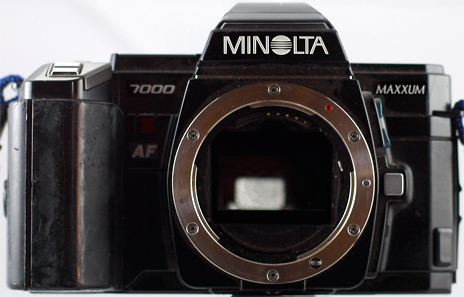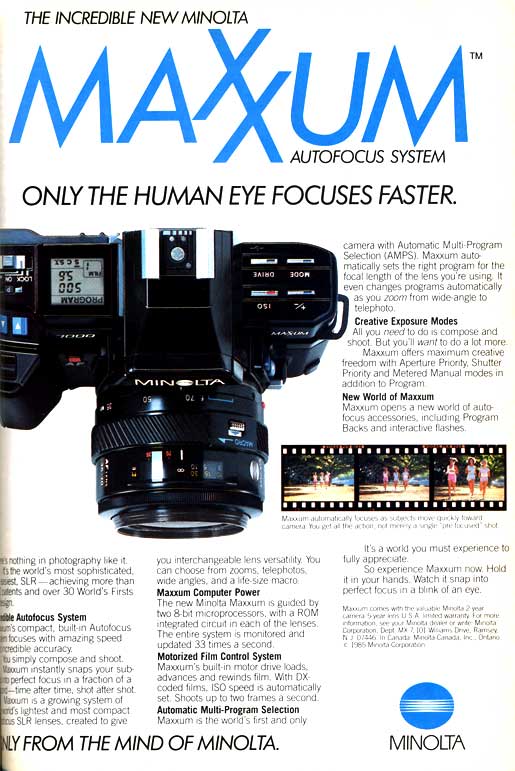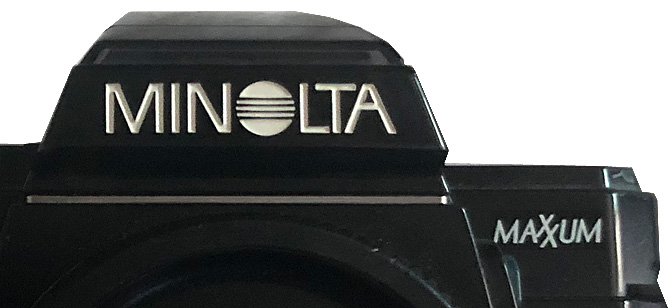
Approx. dates of manufacture: 1986-1988
Lens Mount: Minolta A
Approx. original price: $214.99
Approx. street value: Low
No, the Minolta Maxxum isn't the first SLR with built in autofocusing. That distinction, surprisingly, belongs to a US-made camera, the Polaroid SX-70 Sonar of 1978. However the Maxxum 7000 has the honor of being the first 35mm SLR designed as a full autofocusing camera system from the very first engineering drawing. Taken individually, few of the Maxxum's impressive list of features would be considered world's "firsts" but in concert, they do represent the often sought after but seldom achieved giant leap forward in SLR technology.
—Modern Photography magazine, August 1985, p.56
 Minolta was beaten in the 35mm autofocus market by the Pentax ME-F, the Canon T80, the Nikon F3AF, and probably some others. But they all had a problem: their very successful manual-focus lens mounts.
Minolta was beaten in the 35mm autofocus market by the Pentax ME-F, the Canon T80, the Nikon F3AF, and probably some others. But they all had a problem: their very successful manual-focus lens mounts.
Camera makers learned in the 1960s and 70s that lens mounts locked users into their system. Owners of screw-mount lenses could mix and match lens and camera body makes: you could put a Pentax Takumar on a Praktica body and it worked great. But if you had a Nikon body, you couldn't put Canon FD-mount glass on it, or vice versa. And the more of anything you bought, the more you were locked into the system because if you had a closet full of Nikon bodies and lenses, buying a Canon meant you had to start all over again. The companies that made systems benefitted greatly.
But it locked the camera makers into their own systems as well. Canon, Nikon, et al, were all afraid of introducing a new mount because it opened the opportunity for customers to switch systems. When I wanted to buy a digital SLR, I had to figure out which camera system I was going to go with because I had no autofocus lenses; I could buy anything I wanted because my all my Canon FD lenses wouldn't work anyway.
It also meant the camera makers were going to catch hell from all the people whose manual-focus lenses were suddenly made obsolete. They'd gone through this at least once already when they swiched from non-automatic diaphragms (e.g. the Canon FL mount) to automatic diaphragms (e.g. Canon FD mount).
The camera makers were scared to change mounts again, so they cooked up autofocus systems that would work on their current manual-focus mounts; that way you could still use your existing manual-focus lenses on the new autofocus body (albiet without auto-focus capability). In other words, you had backwards compatibility. The bad part was that none of them worked very well.
Minolta said to hell with it: they started with a clean piece of paper and came up with a whole new system. It was a gamble but it paid off handsomely. They blew the doors of everything in the market, and the Maxxum was a massive hit. Being the first really good autofocus system, an awful lot of people bought them and invested in the Minolta A mount system, which meant they bought more A-mount lenses and Minolta bodies later on. Canon and Nikon ended up creating their own new, incompatible mounts but it took them a long while.
This Maxxum 7000 is the first of the Maxxum line. For a huge seller, it had a relative short (2 years) manufacturing life, but that was largely because autofocus technology developed rapidly and all the major players had to update their cameras often or risk being left behind. These days you can still use the Maxxum 7000 body, but the autofocus is horrendously slow.
 I have two of these. The original logo had the two Xs interlinked similar to Exxon's logo; they sued and Minolta had to change the logo to a more mundane version. Ever since I learned that bit, I've had my eye out for a 7000 with the original logo and figured I'd never find one; or if I did, it would be at a camera show with a premium price. When I found one at a thrift shop, I pounced.
I have two of these. The original logo had the two Xs interlinked similar to Exxon's logo; they sued and Minolta had to change the logo to a more mundane version. Ever since I learned that bit, I've had my eye out for a 7000 with the original logo and figured I'd never find one; or if I did, it would be at a camera show with a premium price. When I found one at a thrift shop, I pounced.
Despite being a huge seller, the Maxxum 7000 doesn't carry much value these days. I paid $10 for my later-logo version, and $20 for the original logo version. (Albiet each were body-only and in so-so cosmetic condition, but that's common for most early-autofocus cameras). One reason the prices are depressed may be that the rubberized hand-grip is turning milky-gray from its original black. My Maxxum 5000i has the same problem, so I assume this is a common ailment. Here's a discussion on Photo.net. I rubbed Armor-All on mine and it did a decent job.
Camera manual: Orphan Cameras.com
One of Modern Photography magazine's Top Cameras
Modern Photography magazine camera test: August 1985


